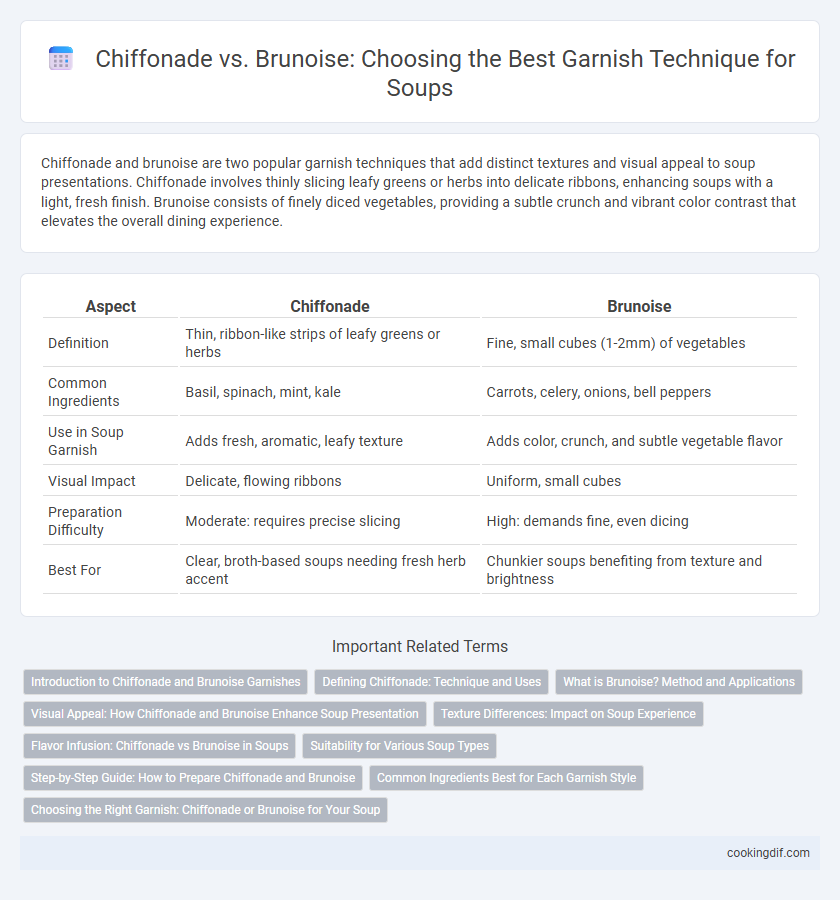Chiffonade and brunoise are two popular garnish techniques that add distinct textures and visual appeal to soup presentations. Chiffonade involves thinly slicing leafy greens or herbs into delicate ribbons, enhancing soups with a light, fresh finish. Brunoise consists of finely diced vegetables, providing a subtle crunch and vibrant color contrast that elevates the overall dining experience.
Table of Comparison
| Aspect | Chiffonade | Brunoise |
|---|---|---|
| Definition | Thin, ribbon-like strips of leafy greens or herbs | Fine, small cubes (1-2mm) of vegetables |
| Common Ingredients | Basil, spinach, mint, kale | Carrots, celery, onions, bell peppers |
| Use in Soup Garnish | Adds fresh, aromatic, leafy texture | Adds color, crunch, and subtle vegetable flavor |
| Visual Impact | Delicate, flowing ribbons | Uniform, small cubes |
| Preparation Difficulty | Moderate: requires precise slicing | High: demands fine, even dicing |
| Best For | Clear, broth-based soups needing fresh herb accent | Chunkier soups benefiting from texture and brightness |
Introduction to Chiffonade and Brunoise Garnishes
Chiffonade and Brunoise are classic knife techniques that enhance soups through distinct garnishes: chiffonade creates delicate, ribbon-like strips of leafy herbs or greens that offer a light, fresh texture and vibrant color, while brunoise produces tiny, evenly diced vegetables that add a refined crunch and concentrated bursts of flavor. Chiffonade is ideal for soft herbs like basil or spinach, layering subtle herbal notes atop the soup's surface, whereas brunoise suits firmer vegetables such as carrots or celery, contributing both visual appeal and textural contrast. Employing these techniques elevates soup presentation and taste by carefully balancing texture, aroma, and color in every spoonful.
Defining Chiffonade: Technique and Uses
Chiffonade is a knife technique that involves stacking leafy greens or herbs, rolling them tightly, and slicing into thin, delicate ribbons, often used for garnishing soups and enhancing presentation. This method contrasts with brunoise, which consists of dicing vegetables into fine, uniform cubes to add texture and flavor complexity. Chiffonade emphasizes visual appeal and delicate texture, making it ideal for leafy herbs like basil or spinach to complement creamy or clear soups.
What is Brunoise? Method and Applications
Brunoise is a culinary knife cut technique where vegetables are finely diced into uniform cubes, typically 1 to 2 millimeters in size, enhancing both texture and presentation in soups and sauces. The method involves julienning the vegetable into thin strips, then carefully dicing them into small, even pieces to achieve precise uniformity. Commonly used for garnishing soups, brunoise adds a delicate crunch and vibrant color without overpowering the dish's flavor profile.
Visual Appeal: How Chiffonade and Brunoise Enhance Soup Presentation
Chiffonade, with its thin, ribbon-like strips, adds a delicate, elegant texture that enhances the visual appeal of soup by creating a vibrant, flowing garnish. Brunoise, consisting of finely diced, uniform cubes, contributes a refined, structured look that introduces color contrast and precision to the presentation. Both techniques elevate soup aesthetics by highlighting freshness and attention to detail, catering to diverse design preferences in culinary plating.
Texture Differences: Impact on Soup Experience
Chiffonade garnish provides a delicate, ribbon-like texture that gently infuses soups with fresh herb flavors, enhancing the sensory experience without overpowering the palate. Brunoise, with its finely diced, uniform cubes, adds a subtle crunch and visual appeal that introduces a contrast to smooth soup bases, elevating the texture complexity. Choosing chiffonade creates a light, aromatic finish, while brunoise delivers a structured, textural bite, impacting the soup's overall mouthfeel and enjoyment.
Flavor Infusion: Chiffonade vs Brunoise in Soups
Chiffonade, with its thin, ribbon-like cuts of herbs or leafy greens, releases delicate aromas and subtle flavors that infuse soups gently, enhancing freshness without overpowering. Brunoise, consisting of finely diced vegetables, allows for a more concentrated flavor release due to increased surface area, adding texture and bursts of taste throughout the soup. The choice between chiffonade and brunoise directly affects how flavors meld, with chiffonade offering a light infusion and brunoise providing robust, distributed seasoning.
Suitability for Various Soup Types
Chiffonade, with its delicate, thinly sliced leafy herbs or greens, is ideal for light, clear soups like consommes or broths, enhancing aroma without overpowering flavor. Brunoise, consisting of finely diced vegetables, complements hearty, thick soups such as bisques or chowders by adding texture and bursts of concentrated flavor. Selecting chiffonade or brunoise garnishes depends on the soup's consistency and desired flavor impact for optimal sensory experience.
Step-by-Step Guide: How to Prepare Chiffonade and Brunoise
To prepare chiffonade for garnish, stack leafy greens like spinach or basil, roll them tightly into a cigar shape, then slice thinly across the roll to create delicate ribbons perfect for soups. For brunoise, first dice vegetables such as carrots or celery into uniform small cubes roughly 1/8 inch in size, which adds a refined texture and visual appeal to the soup. Both techniques require precise knife skills and uniform cuts to enhance presentation and maintain consistent cooking when used as garnish.
Common Ingredients Best for Each Garnish Style
Chiffonade is ideal for leafy herbs like basil, mint, and spinach, as its thin ribbons enhance soups with delicate texture and appearance. Brunoise works best with firm vegetables such as carrots, celery, and bell peppers, providing uniform small cubes that add color and subtle crunch. Selecting the right garnish style depends on the soup's flavor profile and desired visual impact.
Choosing the Right Garnish: Chiffonade or Brunoise for Your Soup
Chiffonade and brunoise each offer distinct textures and visual appeal as soup garnishes, with chiffonade providing delicate, ribbon-like herb or leafy green strips, while brunoise offers tiny, uniform cubes of vegetables that add subtle crunch and color. The choice depends on the soup's flavor profile and presentation: chiffonade enhances herbal freshness in light, clear broths, whereas brunoise complements creamy or chunky soups by adding refined texture and visual complexity. Selecting the appropriate garnish elevates the overall dining experience by balancing taste, texture, and aesthetic appeal.
Chiffonade vs Brunoise for garnish Infographic

 cookingdif.com
cookingdif.com